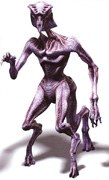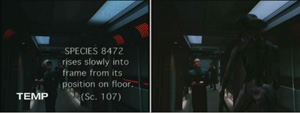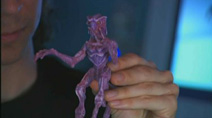|
|
 |
TREKCORE >
VOY >
EPISODES >
SCORPION
PART I &
II >
BEHIND THE SCENES >
Designing Species 8472 Part 3
 |
|
|
|
|
|
Note:
This part contains information relevant to both "Scorpion" and the
later episode "Prey".
It is all included in this section for convenience.
Parts 2 and 3 of "Designing Species 8472" describe an interview
Foundation Imaging's John Teska gave to Star Trek Monthly
about Species 8472. All quotes are from
John Teska unless otherwise indicated. |
|
|
|
|
|
|
 |
Once the last
texture map had been applied, the Species 8472 model was ready for
use which is when a lot of the real work began.
 "Certainly the building process takes quite a
bit of time, but the actual animation process's very demanding. For
each shot there's still many man hours that go into making him live
and breathe and perform." "Certainly the building process takes quite a
bit of time, but the actual animation process's very demanding. For
each shot there's still many man hours that go into making him live
and breathe and perform."
This
particular screenshot shows how the creature is positioned in Lightwave for an
actual production shot. 3D software uses virtual cameras that work
just like the real thing. The screen on the left shows the creature
through the camera's lens. The screen on the right shows a
perspective view with the camera over the creature's shoulder. |
|
|
|
 |
The way the
model behaved was vitally important. Even standing still it looked
threatening, but the way it moved and the expressions on its face
would have to create a sense of danger and communicate its
intelligence.
"I worked closely with Dan Curry on what kind
of motion they were looking for. The main thing they kept pushing
for was to make it very fast, like a striking serpent. They also
wanted to establish that it's a predatory creature but it's smart.
The interesting thing was getting it to seem smart without going for
the obvious things like speaking; I knew they wanted it to be
psychic, so from the very beginning they knew it wouldn't speak.
They wanted to keep it really mysterious so we didn't totally
understand its technology. Really, the only chance to have it be
expressive was in those few closeups we got where the eye sort of
blinks and you get a little bit of eye dilation."
Creating the creature's expressions involved modifying the model
subtly, adding more bones and structures to its face.
|
|
|
|
 |
 Working
out exactly how the creature would move about was not
straightforward. If he had built a model of a person or a dog, he
could have looked at the real thing for guidance, but this was a
completely alien creature with three legs. John explains that, if
anything, he had too many choices because a CG model is not bound by
the laws of physics. Working
out exactly how the creature would move about was not
straightforward. If he had built a model of a person or a dog, he
could have looked at the real thing for guidance, but this was a
completely alien creature with three legs. John explains that, if
anything, he had too many choices because a CG model is not bound by
the laws of physics.
"With this it is just as easy to do the wrong
motion as the right one. You have to make sure you are doing the
right thing. When you're animating, the center of balance is always
a concern. All of the traditional animation rules apply here, like
the head always needs to be between the feet so you know the center
of gravity is balanced, and if something is going to lunge forward
you need to plant a foot behind it. The physical rules still apply;
it's just that as a computer animator you have to work it out as
opposed to when you are dealing with a puppet where there's a
natural motion to it." |
|
|
|
|
|
|
 |
The creature has to move for the benefit of the
camera and that as a consequence it may have to be posed in a rather
strange way.
"You can do just about any pose with it, but
there's a certain amount of cheating going on. It all comes down to
what you actually see on the screen. Very often, you set up a pose
purely for the camera so it looks right through the lens, but if you
look at a side view he might be kind of leaning backwards or
something.
I thought more about getting these attack motions and how he lunges
than about the mundane task of getting down the hallway. clip of
Species 8472 climbing up outside of Voyager from [Prey] That was a
fun shot. There are shots that, as an animator, you really look
forward to. That was one, because it's rare to see a creature in a
full screen shot. The idea that it walks around the outside of the
hull is interesting. The camera does a weird bank into that shot,
orienting itself to the creature on the side. On several fronts it
was a unique shot to do. I was excited that they were going to keep
using this character because I was having fun building him and
animating him. You move onto spaceships and think: "He won't come
back." Then I read the script for [Prey] and there were scenes of
him having hand-to-hand combat." |
|
|
|
|
|
|
 |
Dan Curry, visual effects supervisor on Voyager's
production staff: "8472 appeared in a number
of episodes. The trickiest one was an episode where it fought with
someone ([Prey]). Having to have a CG creature fight with a live
actor was difficult. Ron Moore supervised that episode and did a
great job, working with the director, stunt guy and actors to make
sure we were able to put a really terrific scene together."
|
|
|
|
|
|
|
 |
Teska further recalls, "One of
the difficulties with these characters interacting with the human
beings on board Voyager is that they shoot the principal photography
weeks in advance of when we put the visual effects in. So we had to
work closely with the supervisors on that show and make sure they
anticipated where the character would be and how the actors should
react. 8472 moves through a fritzing forcefield. 8472 lashes out at
Alpha with his arm. I'd built 3D characters before but never a major
recurring character. The most exciting day was when the Species 8472
toys came out. It was the first time I was able to hold this guy and
turn him around. Up until that point it had lived just inside the
monitor, for me. I was really pleased when I saw the toy. You have a
little bit of leftover time. I ended up doing a shot of him between
takes, sitting in the hallway. He was smoking a cigarette and just
kind of relaxing, just like actors in their off-time."

 |
|
|
|
|
|
|
 |
John Teska points out that the TV viewer never sees
Species 8472 walking.
"When we see him in [Scorpion] he basically
bursts through a door on the ship, and he's always just swiping at
people and jumping into frame, so we never had to work out a walk
for him until several episodes later when he reappeared in [Prey].
Even in that show, we don't actually see him walking in a corridor.
The first time we see him locomoting is on the hull of Voyager. In
that case, since he was in the vacuum of space and trying to hold
on, I had him using his arms as well, kind of like a five-limbed,
walking, crawling motion. The main thing I was trying to think of
when I was working on that was how a spider, or an octopus, or
something that had more than the normal two limbs, would move." |
|
|
|
|
|
|
 |
However, even though it was not needed on screen,
John Teska still went to the trouble of designing a walk for the
creature. He explains that CG animation uses something called a walk
cycle, which groups all the movements required to take a step into a
sequence that can be repeated indefinitely.
"A previous Foundation show, Hypernauts had a
three-legged dog creature in it (also designed by Steve Burg). It
had to run around a whole lot, so I had worked out what the run
cycle was for that. I was planning on using the same approach on
Species 8472. You really only have two choices; either you walk like
a pair of crutches with a third leg that comes in between, or you
work out a staggered cycle, which is what I favored. So two legs are
on the ground at any time, but they are cycling through the legs.
You can almost envision it by running your fingers along the desk
top. The hardest part is figuring out what the gait would be - how
far does he reach in an average stride, and how many frames does he
take to do that. Often I just have a piece of paper standing nearby
and I'll actually draw the poses out relatively quickly on the paper
to keep my head straight. So, I'll know at this frame here he's in
this pose, he has to reach this pose by this frame." |
|
|
|
|
|
|
 |
Even though John didn't get the chance to put his
walk cycle into action, he did have the opportunity to subtly tweak
the model every time he worked with it, improving the way it moved.
By the last time he worked with the creature, John felt it was
almost perfect given the technology that was available at the time.
"You always find things you wish you had done
better, and having him return over several episodes gave me a chance
to refine him a little bit. Very often the software grows and you
wish you could change something, but you have deadlines this week.
At this point he is still in Lightwave 5.0 technology. If ever he
were to come back then I'd be tempted to rewire him." |
|
|
|
|
|
|
 |
 John
Teska has an obvious fondness for the creature he built. Looking
back, he says one of the things he enjoyed most was actually
confronting a physical version of his purely digital creation, even
if it was only a few inches tall. John
Teska has an obvious fondness for the creature he built. Looking
back, he says one of the things he enjoyed most was actually
confronting a physical version of his purely digital creation, even
if it was only a few inches tall.
"One of the most exciting moments in the whole
lifespan of Species 8472 is when the toys started to come out. What
was interesting there is the guys who were making the toys contacted
me when they were starting to work on it. What was neat was being
able to actually send them a copy of the model, and it is very
accurately replicated in the toy. When I finally held a Species 8472
in my hand it was really very exciting." |
|
|
|
|
|
|
|
|
<
Part
2 |
Index |
|
|


|
|



